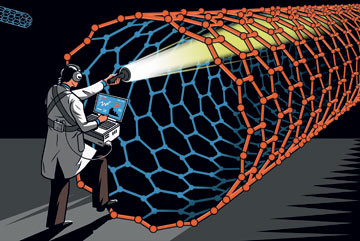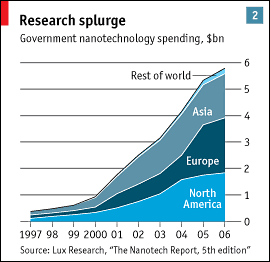The risk in nanotechnologyThe unusual properties of tiny particles contain huge promise. But nobody knows how safe they are. And too few people are trying to find outThe Economist Dec. 06, 2007 |
Popular 
Rep. Thomas Massie Warns Congress is Trying to Pass Hate Speech Laws to Outlaw Criticism of Israel

ADL Urged Congress to Pass FISA Law Spying on Americans to 'Protect Israel'

'Sniper Seen on Roof Overlooking Pro-Palestine Protest' at Indiana University

Axios Poll: Majority of Americans Now Want Mass Deportations

Claim Jewish Student Was 'Stabbed In The Eye' by Pro-Palestine Protester Draws Mockery After Video Released
  WAVING a packet of carbon nanotubes accusingly at the assembled American politicians during a hearing last month in Congress, Andrew Maynard was determined to make a point. The nanotechnology expert at the Woodrow Wilson International Centre for Scholars in Washington, DC, had bought the tiny tubes on the internet. They had arrived in the post along with a safety sheet describing them as graphite and thus requiring no special precautions beyond those needed for a nuisance dust. WAVING a packet of carbon nanotubes accusingly at the assembled American politicians during a hearing last month in Congress, Andrew Maynard was determined to make a point. The nanotechnology expert at the Woodrow Wilson International Centre for Scholars in Washington, DC, had bought the tiny tubes on the internet. They had arrived in the post along with a safety sheet describing them as graphite and thus requiring no special precautions beyond those needed for a nuisance dust.Dr Maynard's theatrics were designed to draw attention to a growing concern about the safety of nanotechnology. The advice he had received was at best uncertain, and at worst breathtakingly negligent. For a start, describing carbon nanotubes as graphite was rather like describing a lump of coal as a diamond. Graphite is made of carbon, just like the nanotubes, although the tubes themselves are about 1m times smaller than the graphite that makes up the “lead” in a pencil. Carbon nanotubes may be perfectly safe, but then again, they may have asbestos-like properties. Nobody knows. Indeed, industry, regulators and governments know little about the general safety of all manner of materials that are made into fantastically small sizes. This lack of knowledge is so great that research can paradoxically add to the problem. Vicki Colvin, a professor of chemistry at Rice University in Texas and one of the world's leading experts in nanotechnology-risk research, told the same hearing: “If you fund five teams to understand nanotube toxicity, and they get five different answers, your research investment hurts you, because it creates uncertainty. The bad news is that we have way over five different opinions about carbon-nanotube toxicity right now.”  In the past few years the number of consumer products claiming to use nanotechnology has dramatically grown—to almost 600 by one count. Patents are rapidly being filed (see chart 1). For a product to count as nanotechnology, it does not need to contain a tiny machine—though some seers imagine that as the field's ultimate aim. It is enough merely for some of the material to have been tinkered with at a small scale. Often that can involve grinding down a substance into particles that may be only a few nanometres big—a nanometre is a billionth of a metre—about 100,000th of the thickness of a sheet of paper. These particles can also be engineered into shapes that provide some functional property, like rigidity. The variety of shapes includes rings, shells, wires, beads, cages and plates. The particles and shapes can also be incorporated into other materials to bestow useful properties on them. Honey, I shrunk the silver Some nanotechnology products are applied directly to the skin, as cosmetics and sunscreens. Titanium dioxide is commonly used as the white pigment in sunscreen. When it is ground into nanoparticles it can still block harmful ultraviolet radiation, but it allows visible light to pass straight though, which means modern sunscreens can appear completely transparent, while offering the same protection as the old white stuff. Many products are now embedded with silver nanoparticles. At such small sizes, silver can have antimicrobial properties. Silver nanoparticles may come in handy wherever you want to kill germs—for instance, in things as diverse as children's dummies (comforters to Americans), teddy bears, washing machines, chopsticks and bed linen. Hence nanotechnology can be used in food production, most often as nanoparticles of silver in food-preparation equipment. The food industry is also trying to restructure ingredients at the nanoscale so as to include particles of trace metals in food supplements and to produce less-fattening foods. All that sounds alarming, but assessing the risks calls for perspective. Humans are already surrounded by nanoparticles of one sort or another. Much of the food people eat is made of naturally occurring nanoscaled components. Each person breathes in at least 10m nanoparticles a minute. Most of them do no harm. The trouble is that some—such as the particles from a diesel-engine exhaust—are known to cause serious health problems. Moreover, despite hundreds of years of experience in chemistry, it is not easy to predict how a substance will behave when it is made extremely small. That means, you cannot be sure how it will affect health. Nanoparticulate versions of a material can act in novel ways—indeed, as with silver, that is what makes them so useful. When they are very, very small, materials, such as copper, that are soft can become hard. Materials, such as gold, that would not react to other substances become reactive. And when they have been shrunk, materials, such as carbon, that are perfectly safe might become unsafe. Plenty of research suggests that nanoparticles of harmless substances can become exceptionally dangerous. One reason for this change is that a tiny thing has a large surface area relative to its mass. Atoms on the surface of a material are generally more reactive than those inside (which is why powders dissolve more quickly than solids do). Half of the atoms in a five-nanometre particle are on its surface, which can make it many times more toxic than expected by weight alone. Nanoparticles are small enough to be transported into the human body more easily and into the environment in new ways. Research on animals suggests that nanoparticles can even evade some of the body's natural defence systems and accumulate in the brain, cells, blood and nerves. Studies show there is the potential for such materials to cause pulmonary inflammation; to move from the lungs to other organs; to have surprising biological toxicity; to move from within the skin to the lymphatic system; and possibly to move across cell membranes. Moreover, these effects vary when particles are engineered into different shapes. There is currently no way of knowing how each shape will behave, except by experiment. Britain's Royal Society was concerned enough about all this to recommend in 2004 that nanoparticles be treated as entirely new substances. The European Commission concluded that each new material should be assessed on a “case by case basis”. However, understanding the environmental, health and safety (collectively known as EHS) risks is difficult. Many governments take the view that, in terms of product-safety, nanotechnology changes nothing. The responsibility for managing EHS risk remains with companies themselves. Firms must make sure that the goods they produce are safe for consumers, that their workers are healthy and that their factories and products do not cause damage to the environment. On the whole, that is the right approach in a market economy, but the uncertainties make it hopelessly over-optimistic for nanoparticulates. In the absence of any firm guidance from governments as to exactly what tests are needed to ensure a product is safe, businesses are devising their own. Michael Holman, an analyst with Lux Research, an emerging-technology consultancy based in New York, says that larger companies can probably cope with the research because they are more familiar with the risks of liability and regulation. But the task is beyond some small companies. “We talk to them and they say they are just doing titanium dioxide and they are not concerned, because it is a safe material, and we think they're whistling to the graveyard on EHS risks,” he says. The analysts at Lux reckon that the applications that are likely to cause most (real and perceived) concern are those intended to go into or onto the body: cosmetics, food additives, pharmaceutical-delivery systems, novel therapeutics and textile coatings and treatments. But Lux says there is also a lot of uncertainty over what happens to these substances at the end of their lives. Carbon nanotubes have been used for years in industry. They have been embedded in materials like plastics to increase their toughness and provide electrical conductivity for components that are electrostatically painted. But it remains unknown, for instance, if they can enter groundwater when the products that contain them are dumped or broken up.  Businesses have good reason to make safe products. But the temptation for a company, especially a small one, is to spend its precious research budget on new products rather than basic investigations into the safety of nanotechnology that would benefit everyone, including its competitors. The risks may end up being carried by insurers. However, Swiss Re, one of the biggest insurers and one that has taken an early interest in nanotechnology, reckons insurers are not yet fully able to assess the risks. At the moment, firms with product-liability insurance are implicitly insured for their nanoparticles. One hope is that the insurers will demand more certainty. Another, given the fundamental principles that have still to be established, is that some of the money governments are pouring into nanotechnology (see chart 2) will be diverted into the basic safety research the technology needs to thrive. Patchy, at best Although scientists' favourite alarm call is that “more research is necessary”, the extent and the frequency of their cry suggests that in nanotechnology they may be right. The Nanotechnology Industries Association, a British trade body for companies operating in the field, wants better co-ordination in the way that money is spent on nanotechnology-risk research. According to Steffi Friedrichs, the association's director, “current research projects and their results are patchy to say the least.” Research tends to be in areas that interest scientists, rather than what would be most useful for industry as a whole let alone the protection of consumers. For several years there have been complaints about a lack of organisation and leadership. Earlier this year the Council for Science and Technology, which advises the British government, warned that progress on risk research into the toxicology, health and environmental effects of nanomaterials was far slower than promised. It said there was a “pressing need” for a strategic programme of spending. It is much the same story in America, where the co-ordination and planning of risk research is also taking years longer than anyone would have imagined. This has frustrated Brian Baird, the chairman of one of Congress's science committees. On October 31st he told the government's National Nanotechnology Initiative (NNI), that it was not acceptable that its EHS strategy, and its implementation plan, had not materialised some 18 months after it was due. Simple prudence, he said, suggests urgency in making sure that the work catches up with, or even surpasses, the pace of commercialisation. America already spends the most on EHS research into nanotechnology. Depending on who does the counting, it ranges from $11m to $60m. But of the larger, government-claimed figure, nobody is able to say precisely what this money is buying. Whatever the actual figure, Dr Maynard, waver of the carbon nanotubes in Congress, says that at least $100m per year is needed in the next few years to finance research into just some of the basic questions. Along with a number of other leading scientists, he published a paper in the journal Nature last year that outlined the sort of research programme needed to put the understanding of nanotechnology risk onto a sounder footing. What are the most important things such a programme could produce? Dr Maynard says he would like to see ways of measuring exposure to nanoparticles in the air and water; a method of getting a rough idea of what the toxicity of a nanoparticle might be, ideally with some quick and basic tests that could inform scientists and businesses of the most promising (and safest) routes to pursue; and guidelines for how to work safely with nanoparticles, including clearing up spills and managing waste. This does not sound like much to ask, but it is a long way from happening. In America some scientists worry about a conflict of interest at the NNI—because it must both promote nanotechnology and mitigate its risks. In fact inertia is more likely to spring from the NNI's need to get 23 government agencies to agree on a research agenda. Clayton Teague, the head of the NNI, has no authority to twist arms. This increases uncertainty over the safety of nanotechnology and makes the question of whether more regulation is needed a tricky one. Today's legislation is based on an ability to measure and monitor materials, and calculate risk. In Europe legislators have concluded that, although nanomaterials are covered by existing rules, this will not amount to much unless you have a way to identify hazards and evaluate risks. Terry Davies, a fellow at Resources for the Future, an economics think-tank based in Washington, DC, and a former assistant administrator for the Environmental Protection Agency, says that American legislation, such as that for clean air and water, is based entirely on standards and the ability to monitor them. “We don't have a clue what kind of standards there are for nanoparticles in air or water,” he says. Some sampling of airborne particles is done, but it is still not clear what should be monitored. And in water there is no ability to monitor the presence of nanomaterials. Even if these things could be measured, he adds, nobody knows how to control them. Weighing the smallest Managing the risks in nanotechnology is a massive undertaking that will take years to develop and it requires careful planning and co-ordination, says Dr Colvin. It will also depend on scientists from around the world working together. They could start by agreeing on a common form of terminology and some basic skills and tools, such as how to measure nanomaterials, characterise them and ensure their purity. At the moment it is virtually impossible to weigh a ten nanometre-sized particle with any accuracy. All this work is being co-ordinated via the International Standards Organisation in Geneva, and presumably one day it will happen. Meanwhile, nanotechnology is becoming part of the global economy. It could help produce trillions of dollars of products by 2014, ranging from face creams to computer chips and car panels, according to Lux Research. The risks from these products will often be very low or non-existent. In the computer industry, for instance, making smaller and smaller features on the surface of a chip is not likely to involve much risk to computer users. Motorists probably have little to fear from carbon nanotubes being embedded into a car door to make it more crash-resistant. Yet what happens to such products at the end of their life remains a question. At the same time, nobody wants to stifle the innovation and potential benefits that nanotechnology promises. Ultra-small particles that are able to enter the brain might be used to deliver treatments for brain diseases. Nanomaterials also offer huge potential for making better batteries, generating green energy and producing clean water. It is little wonder that governments have been falling over themselves to put money into nanotechnology research. Slower to arrive has been the leadership and funding to do the necessary risk research, and to make sure that existing agencies can regulate a large, new, poorly understood area of risk. Mihail Roco, a senior adviser at America's National Science Foundation and one of the architects of the NNI, wrote earlier this year that nanotechnology research and development has advanced faster than the capacity of regulators to assess its social and environmental impact. Scientists do not mean that nanoparticles are inherently unsafe, only that there is a yawning gap in understanding their effects. Yet safety legislation cannot be expected to work until the products of the technology are better understood. What does it mean to regulate nanotechnology materials when you cannot even measure their release into the environment or agree on how to weigh a nanoparticle? In the longer term, researchers think that they will be able to devise a framework for understanding nanoparticles and predicting which will be hazardous before they are ever made. That would allow science, technology and business to focus on the materials that are most likely to be beneficial and profitable. It would be a huge prize, because it would enable the development of nanotechnology while guarding against a big health scare or environmental disaster. If, in the aftermath of an accident, the public discovered that scientists are unsure about a wide range of nanotechnology, it would wreck the development of potentially valuable and safe new products. Had Dr Maynard's bag split wide open in Congress, scattering his carbon nanotubes into the air, would any harm have been caused? Probably not. But, as an answer, “probably” is not good enough. |



